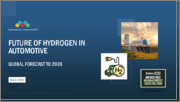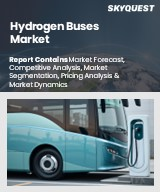
|
시장보고서
상품코드
1462411
세계의 자동차 시장에서 수소의 미래 예측(-2035년) : 차종별, 추진 유형별, 수소 보급 포인트별, 지역별Future of Hydrogen in Automotive Market by Vehicle Type, Propulsion Type, H2 Refueling Points and Region - Global Forecast 2035 |
||||||
세계의 자동차에서 수소의 미래 시장 규모는 2024년 2만 3,000유닛으로부터 2035년까지 35만 3,000유닛으로 확대하며, CAGR은 28.3%에 달할 것으로 예측됩니다.
| 조사 범위 | |
|---|---|
| 조사 대상 연수 | 2024-2035년 |
| 기준년 | 2023년 |
| 예측 기간 | 2024-2035년 |
| 고려된 유닛 | 가치(유닛) |
| 부문 | 차종별, 추진 유형별, 수소 보급 포인트별, 지역별 |
| 대상 지역 | 아시아태평양, 유럽, 북미 |
배출량 증가, 연료 가격 상승, 화석연료의 수급 어려움으로 인해 최근 수년간 무공해 대체연료 자동차에 대한 수요가 급증하고 있습니다. 이러한 수요 급증은 수소 모빌리티에 대한 관심 증가에 크게 기여하고 있습니다. 비귀금속 촉매 기반 양성자 교환막 연료전지(PEM FC), 수소 연료전지 패키지 시스템 모듈, 소형 경량 미세구조 등 대체 기술의 발전은 차량의 주행거리를 늘리고, 비용을 낮추며, 전반적인 효율성을 향상시킬 것으로 기대됩니다. 마찬가지로, 파워트레인 기술의 발전은 수소연료전지차 시장에 새로운 길을 열어줄 것으로 기대됩니다. 또한 연료전지 하이브리드 전기자동차(FCHEV)와 수소 내연기관 자동차(H2-ICEV)와 같은 새로운 수소 기반 자동차의 출현은 시장 상황에 새로운 전망을 제시할 것입니다. 또한 수소 인프라에 대한 정부의 지원과 충전소 개발에 대한 관심 증가는 예측 기간 중 시장 성장에 크게 기여하는 요인 중 일부입니다.
"H2 연료 스테이션 분야는 아시아태평양이 주도할 것으로 예상됩니다."
H2 연료 스테이션 분야는 아시아태평양을 선도할 것으로 예상되며, 2035년까지 14,000개 이상의 연료 스테이션이 건설될 것으로 예상됩니다. 현재 이 분야를 선도하는 국가는 중국으로, 전국적으로 급속한 H2 연료 스테이션 건설이 진행되고 있으며 2024년 1월 현재 400개 이상의 연료 충전소가 운영되고 있습니다. 마찬가지로 일본은 2025년까지 320개의 수소충전소를 설립할 계획을 세우고 있습니다. 각국 정부의 이러한 노력은 이 지역의 자동차 시장에서 수소의 보급을 촉진할 것으로 예상됩니다.
"승용차 부문은 예측 기간 중 차종별로 큰 폭의 성장이 예상됩니다."
승용차 부문은 예측 기간 중 연평균 49.4%의 성장률을 보이며 2035년까지 약 264,000대에 달할 것으로 예상됩니다. 유럽에서는 승용차 부문이 시장 점유율의 80%를 차지하며 우위를 유지하고 있으며, BMW, 기아자동차, 현대자동차와 같은 유명 전기자동차 제조업체들이 2024년 말까지 수소연료전지 승용차 시장에서 입지를 구축할 것으로 예상됩니다. 가장 많이 팔리는 수소연료전지 승용차 모델로는 Toyota Mirai, Hyundai NEXO 등이 있습니다.
세계의 자동차 시장에서 수소의 미래에 대해 조사했으며, 차종별, 추진 유형별, 수소 보급 포인트별, 지역별 동향 및 시장에 참여하는 기업의 개요 등을 정리하여 전해드립니다.
목차
- 조사의 목적
- 시장의 정의
- 주요 단체 리스트
- 서론
- 시장 역학
- 에코시스템 분석
- 밸류체인 분석
- 2023년 수소 연료 자동차 시장에 관한 주요 인사이트
- 기술 분석
- 기술 로드맵
- 유망한 비즈니스 모델
- TCO 분석
- H2생성과 휴대용 연료 보급의 동향
- 자동차용 H2와 기타 연료 유형의 비교에 관한 MNM의 견해
- 자동차에서 수소의 이용 사례에 관한 MNM의 견해
- FCEV의 향후 발매 계획에 관한 MNM의 견해
- 대형 상용차에서 H2의 사용 사례
- 오프로드차량에서 H2의 사용 사례
- H2 내연기관차에서 H2의 사용 사례
- H2 클래스 8 트럭 아키텍처의 비교
- H2-ICE 차량 시장 투입 타임라인
- 서론
- 아시아태평양
- 유럽
- 북미
- 서론
- 승용차
- 소형 상용차(LCV)
- 버스
- 트럭
- 서론
- 연료전지차
- FCHEV
- H2-ICEV
- 서론
- 아시아태평양
- 유럽
- 북미
- 개요
- 주요 참여 기업의 전략/비책
- 주요 FCEV 프로바이더의 협업과 성장 계획
- 에코시스템에서 기업의 전방/후방 통합 전략
- 경쟁 벤치마킹
The global future of hydrogen in automotive market size is projected to grow from 23 thousand units in 2024 to 353 thousand units by 2035, at a CAGR of 28.3%.
| Scope of the Report | |
|---|---|
| Years Considered for the Study | 2024-2035 |
| Base Year | 2023 |
| Forecast Period | 2024-2035 |
| Units Considered | Value (Units) |
| Segments | Vehicle Type, Propulsion Type, H2 Refueling Points (Asia Pacific, Europe, and North America) and Region |
| Regions covered | Asia-Pacific, Europe, and North America |
The increasing emission levels, rising fuel prices, and limited availability of fossil fuels have spurred a burgeoning demand for zero-emission alternative fuel vehicles in recent years. This surge has notably contributed to the increasing interest in hydrogen mobility. Advancements in alternative technologies, including non-precious metal catalyst-based Proton Exchange Membrane Fuel Cells (PEM FC), hydrogen fuel-cell packaged system modules, and compact, lightweight microstructures, are expected to enhance vehicle range, decrease costs, and augment overall efficiency. Similarly, advancements in powertrain technology are expected to unveil fresh avenues within the hydrogen-fuel vehicle market. Additionally, the emergence of novel hydrogen-based applications such as Fuel Cell Hybrid Electric Vehicles (FCHEVs) and Hydrogen Internal Combustion Engine Vehicles (H2-ICEVs) is set to generate new prospects within the market landscape. Further, growing focus on hydrogen infrastructure with supportive government efforts, as well as the development of charging stations, are some of the factors that will significantly contribute to market growth during the forecast period.
"H2-Fuel station segment is expected to lead by Asia Pacific region ."
The H2 fuel station segment is expected to lead the Asia Pacific region, projecting over 14 thousand fuel stations by the year 2035. China currently leads this segment, demonstrating rapid establishment of H2 fuel stations nationwide, with over 400 refueling stations operational as of January 2024. Similarly, Japan has outlined plans to establish 320 hydrogen stations by 2025. These initiatives by respective governments are anticipated to boost hydrogen in the automotive market within the region.
"Passenger car segment expected to grow at significant rate during the forecast period by Vehicle type"
The passenger car segment is projected to demonstrate a growth rate, of CAGR 49.4% during the forecast period, reaching an estimated 264 thousand units by the year 2035. Within Europe, the passenger car segment retained its dominance, commanding 80% of the market share. Esteemed EV manufacturers such as BMW, KIA, and Hyundai are expected to establish their presence in the hydrogen fuel cell passenger car market by the end of 2024. Some of the best-selling FCEV passenger car models include Toyota Mirai and Hyundai NEXO.
"Europe expected to be the fastest growing market during the forecast period."
Europe is expected to emerge as the fastest-growing market for FCEVs with new hydrogen plans announced by the EU to set up H2-fueling stations every 200km. Further supportive policies by the government are expected to bolster the market. For instance, the UK had announced plans for 4,000 fuel-cell buses by 2025. FCEV demand in Europe is mainly led by Germany, France, the Netherlands, and Switzerland. LCVs are the fastest-growing market in the region. Similarly, Toyota Motor Corporation (Japan) has been leading the European FCEV market.
In-depth interviews were conducted with CEOs, managers, and executives from various key organizations operating in this market.
- By Respondent Type - OEMs - 24% , Tier I - 67% , Tier II & III - 9%
- By Designation - C- level Executives - 33% , Managers - 52% , Executives - 15%
- By Region - North America - 28%, Asia Pacific - 38%, Europe - 34%
The future of hydrogen in automotive market is dominated by established players such as Toyota Motor Corporation (Japan), Hyundai Motor Company (South Korea), SAIC Motors (China), FAW (China), and Yutong (China) among others. These companies manufacture fuel cell cars, buses, trucks, and LCVs with features such as higher range, and better fuel efficiency compared to ICE vehicles. Additionally, These companies have set up R&D facilities to develop best-in-class products as an alternative to EVs.
Research Coverage:
The report covers the future of hydrogen in automotive market, in terms of vehicle type (Passenger Cars , LCV,Bus, Truck), H2 fuel station (Asia Pacific, Europe, and North America), propulsion (FCEV, FCHEV, and H2-ICE), and region (Asia Oceania, Europe, and North America). It also covers the competitive landscape and company profiles of the major players in the future of hydrogen in automotive market ecosystem.
Key Benefits of the Report
- The study also includes an in-depth competitive analysis of the key players in the market, along with their company profiles, key observations related to product and business offerings, recent developments, and key market strategies.
- The report will help the market leaders/new entrants in this market with information on the closest approximations of the revenue numbers for the overall future of hydrogen in automotive market and the subsegments.
- This report will help stakeholders understand the competitive landscape and gain more insights to position their businesses better and plan suitable go-to-market strategies.
- The report also helps stakeholders understand the pulse of the market and provides them with information on key market drivers, restraints, challenges, and opportunities.
The report provides insights on the following pointers:
- Analysis of key drivers (better fuel efficiency and increased driving range, rapid increase in investment and development for green hydrogen production, fast refuelling, reduced Oil dependency, lower emissions compared to other vehicles), restraints (highly flammable, hard to detect hydrogen leakage, high initial investment or hydrogen refuelling infrastructure, lower efficiency compared to BEV's and HEVs), challenges (rising demand for fuel cell vehicles in automotive and transportation sector, fuel cell vans to be an emerging opportunity for OEMs, government initiatives pertaining to hydrogen infrastructure ), and opportunities (high vehicle costs, insufficient hydrogen infrastructure, fast growing demand for BEVS and HEVs), influencing the growth of the authentication and brand protection market.
- Product Development/Innovation: Detailed insights on upcoming technologies, research & development activities, and new product & service launches in the automotive fuel cell market.
- Market Development: Comprehensive information about lucrative markets - the report analyses the future of hydrogen in automotive market across varied regions.
- Market Diversification: Exhaustive information about new products & services, untapped geographies, recent developments, and investments in the future of hydrogen in automotive market.
- Competitive Assessment: In-depth assessment of market ranking, growth strategies, and service offerings of leading players Toyota Motor Corporation (Japan), Hyundai Motor Company (South Korea), SAIC Motors (China), FAW (china), and Yutong (China) among others in future of hydrogen in automotive market.
TABLE OF CONTENTS
1. INTRODUCTION
- 1.1 OBJECTIVES OF THE STUDY
- 1.2 MARKET DEFINITION
- 1.3 LIST OF KEY ASSOCIATIONS
2. MARKET OVERVIEW
- 2.1 INTRODUCTION
- 2.2 MARKET DYNAMICS
- 2.3 ECOSYSTEM ANALYSIS
- 2.4 VALUE CHAIN ANALYSIS
- 2.5 KEY H2 FUELED AUTOMOTIVE MARKET INSIGHTS OF 2023
- 2.6 TECHNOLOGY ANALYSIS
- 2.7 TECHNOLOGY ROADMAP
- 2.8 PROMISING BUSINESS MODELS
- 2.9 TCO ANALYSIS
- 2.10 H2 GENERATION AND PORTABLE REFUELING TRENDS
- 2.11 MNM INSIGHTS ON COMPARISON OF H2 VS OTHER FUEL TYPES FOR AUTOMOTIVE
- 2.12 MNM INSIGHTS ON USE CASES FOR HYDROGEN IN AUTOMOTIVE
- 2.13 MNM INSIGHTS ON UPCOMING LAUNCH PLANS FOR FCEVS
- 2.14 H2 USE CASE IN HEAVY-DUTY COMMERCIAL VEHICLES
- 2.15 H2 USE CASE IN OFF-ROAD VEHICLES
- 2.16 H2 USE CASE IN H2-ICE VEHICLES
- 2.17 H2 CLASS 8 TRUCK ARCHITECTURE COMPARISON
- 2.18 H2-ICE VEHICLE MARKET LAUNCH TIMELINE
3. MNM INSIGHTS ON H2 FUEL STATION SETUP
- 3.1 INTRODUCTION
- 3.2 ASIA PACIFIC
- 3.3 EUROPE
- 3.4 NORTH AMERICA
4. FUTURE OF HYDROGEN IN AUTOMOTIVE, VEHICLE TYPE OUTLOOK
- 4.1 INTRODUCTION
- 4.2 PASSENGER CAR
- 4.3 LIGHT COMMERCIAL VEHICLE
- 4.4 BUS
- 4.5 TRUCK
5. FUTURE OF HYDROGEN IN AUTOMOTIVE, PROPULSION TYPE OUTLOOK
- 5.1 INTRODUCTION
- 5.2 FCEV
- 5.3 FCHEV
- 5.4 H2-ICEV
6. FUTURE OF HYDROGEN IN AUTOMOTIVE, REGIONAL OUTLOOK
- 6.1 INTRODUCTION
- 6.2 ASIA PACIFIC
- 6.2.1 CHINA
- 6.2.2 JAPAN
- 6.2.3 SOUTH KOREA
- 6.2.4 INDIA
- 6.3 EUROPE
- 6.3.1 GERMANY
- 6.3.2 FRANCE
- 6.3.3 UK
- 6.3.4 SPAIN
- 6.3.5 AUSTRIA
- 6.3.6 THE NETHERLANDS
- 6.3.7 SWEDEN
- 6.3.8 NORWAY
- 6.3.9 ITALY
- 6.4 NORTH AMERICA
- 6.4.1 US
- 6.4.2 CANADA
7. COMPETITIVE LANDSCAPE
- 7.1 OVERVIEW
- 7.2 KEY PLAYER STRATEGIES/ RIGHT TO WIN
- 7.3 COLLABORATIONS AND GROWTH PLANS OF LEADING FCEV PROVIDERS
- 7.4 FORWARD/BACKWARD INTEGRATION STRATAGIES OF COMPANIES IN ECOSYSTEM
- 7.5 COMPETITIVE BENCHMARKING
8. RECOMMENDATIONS BY MARKETSANDMARKETS
9. APPENDIX



















